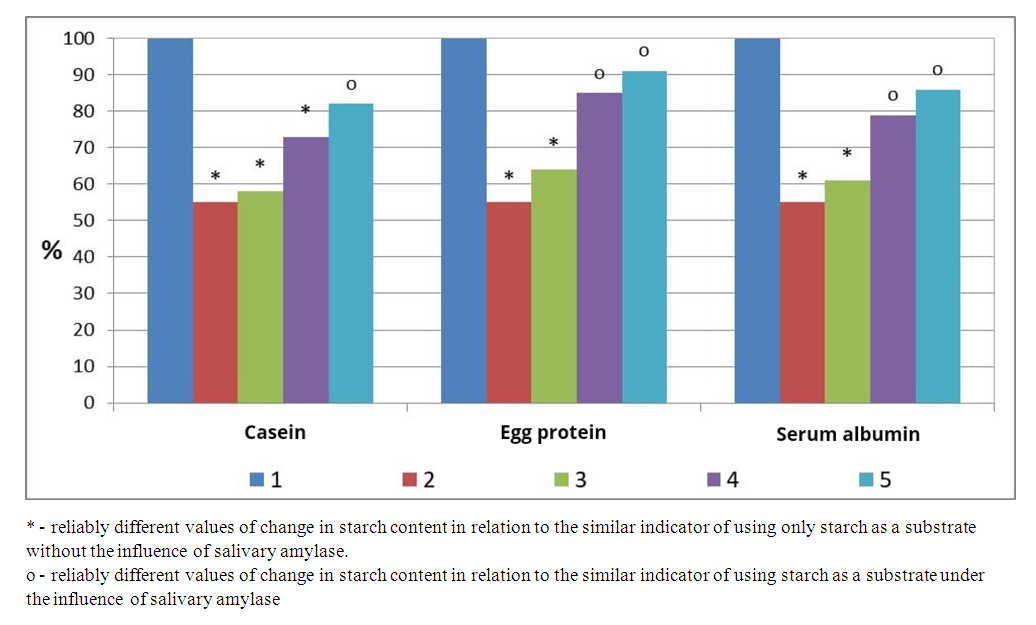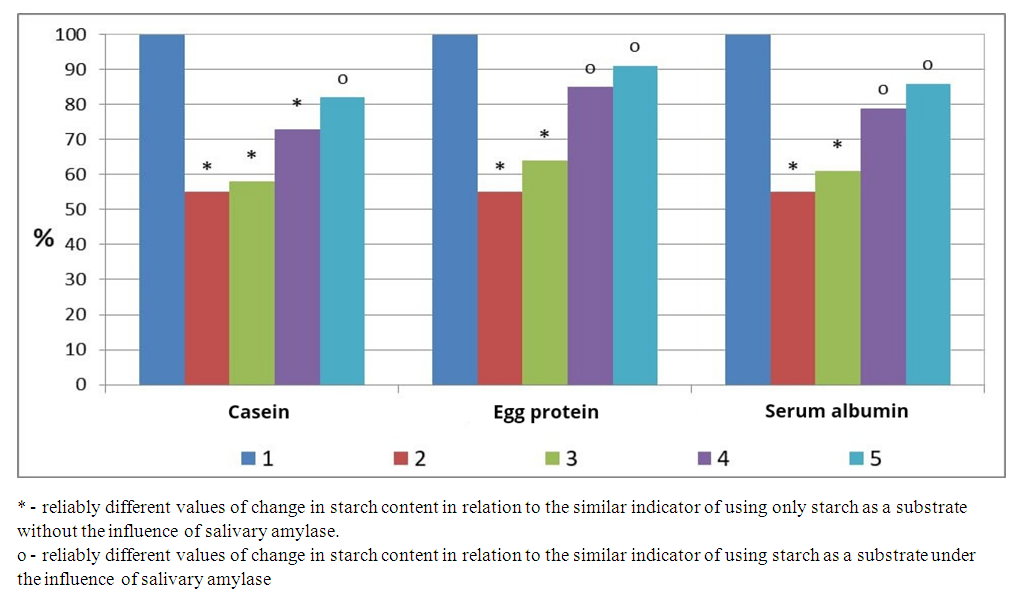-
Paper Information
- Paper Submission
-
Journal Information
- About This Journal
- Editorial Board
- Current Issue
- Archive
- Author Guidelines
- Contact Us
American Journal of Medicine and Medical Sciences
p-ISSN: 2165-901X e-ISSN: 2165-9036
2024; 14(12): 3253-3257
doi:10.5923/j.ajmms.20241412.36
Received: Nov. 7, 2024; Accepted: Dec. 12, 2024; Published: Dec. 19, 2024

Factors Affecting Changes in Starch Digestibility in Interaction with Proteins in Starch-Protein Content
D. S. Kasimova, V. A. Aleinik, S. M. Babich, Sh. Kh. Khamrakulov
Andijan State Medical Institute, Uzbekistan
Copyright © 2024 The Author(s). Published by Scientific & Academic Publishing.
This work is licensed under the Creative Commons Attribution International License (CC BY).
http://creativecommons.org/licenses/by/4.0/

The work studied in vitro the factors affecting changes in starch digestibility in interaction with proteins in the composition of starch-protein substrates. As a result of the study it was established that with an increase in the time of co-presence and interaction of starch with proteins there is a decrease in the digestibility of starch under the influence of salivary amylase and an increase in its content in starch-protein content. In addition, with the use of a substrate containing starch with proteins and an increase in the interaction time of salivary amylase and proteins a decrease in the digestibility of starch under the influence of salivary amylase and an increase in its content in the composition of starch-protein substrates were observed. These changes are due to the fact that salivary amylase acts on starch-protein content, factors preventing the hydrolysis of starch can be the formation of starch-protein complexes, as well as the inhibitory ability of salivary amylase by proteins.
Keywords: Salivary amylase, Starch, Casein, Egg white, Serum albumin, Interaction, Hydrolysis, Digestion
Cite this paper: D. S. Kasimova, V. A. Aleinik, S. M. Babich, Sh. Kh. Khamrakulov, Factors Affecting Changes in Starch Digestibility in Interaction with Proteins in Starch-Protein Content, American Journal of Medicine and Medical Sciences, Vol. 14 No. 12, 2024, pp. 3253-3257. doi: 10.5923/j.ajmms.20241412.36.
Article Outline
1. Introduction
- Starch is a major component of cereals, existed among other macronutrients including protein. It had been reported that starch-protein interactions affects the quality and functionality of food products, e.g. [2,3,5,8]. Consumption of natural foods containing complex matrices may be more nutritious and beneficial than those with isolated nutrients [6]. Starch that is slowly digested or resistant to digestion in the human gastrointestinal tract has beneficial nutritional outcomes. On the other hand, rapid digestion of starch results in a high glycemic response which is considered a risk factor for the development of type 2 diabetes mellitus. However, it is difficult to clarify or quantify the contribution of macronutrient interactions to starch digestibility in a real food environment due to the complexity of food structure.As a model system the digestion of each of the three macronutrients on raw wheat flour (starch, protein, lipid) is affected by interactions with each of the other two macronutrients [2]. Protein is the second most abundant macronutrient in wheat and a continuous protein matrix surrounding starch granules may be formed after aqueous hydration of wheat flour, i.e., during dough formation, which is an important intermediate step for the conversion of flour into many products (e.g., bread, pasta, and noodles). However, there is a lack of information on macronutrient interactions in whole foods after exposure to hydrothermal processing which is more relevant for the form of food that is commonly consumed. Thus, the influence of macronutrient interactions on starch digestibility in foods, the identification of food microstructures with distinct starch digestibility in foods, and the identification of representative materials on starch digestibility in relation to the presence of other macronutrients proved to be of a great interest. Although the use of model materials inevitably ignores some characteristics of large-scale food structures, combinations of components can be used to approximate complexity [1,4,7].Aim of the study: to investigate the affecting factors on the changes in starch digestibility during the interaction with proteins in starch-protein contents.
2. Material and Methods
- Saliva obtained by the spitting method from volunteers was investigated. The influence of preliminary interaction of starch and proteins on the change of starch content under the influence of salivary amylase in the composition of starch-protein content was studied in vitro. Starch with proteins was used without pre-incubation of starch with proteins as well as with 30 min pre-incubation and with 60 min pre-incubation of starch with proteins. In addition, we investigated in vitro the effect of protein and salivary amylase pre-incubation interaction on the change in starch content when salivary amylase was exposed to starch-protein content. Proteins with salivary amylase without pre-incubation, proteins with salivary amylase with 30 min pre-incubation, and proteins with salivary amylase with 60 min pre-incubation were used in these conditions. The content of residual starch under the influence of salivary amylase was analyzed by blue staining with iodine reagent, as well as the content of residual starch in the presence of proteins under the influence of salivary amylase, which was expressed as a percentage of the uninfluenced starch content of salivary amylase.Statistical processing was carried out using the method of variation statistics with calculation of average values and their average errors, determination of the reliability coefficient of the Student-Fisher difference (t). Differences were considered statistically significant at p<0.05 or less.
3. Results
- Based on the data obtained, it was found that when the effect of starch-casein interaction on starch hydrolysis rates under the influence of salivary amylase was studied (Figure 1) using a substrate containing only starch under the influence of salivary amylase the residual starch rate constituted 55±5.1%. This result was significantly (P<0.001) lower compared with similar starch values without salivary amylase influence. Meanwhile, under the influence of salivary amylase on the substrate containing starch with casein without pre-incubation, the result of residual starch was 63±5.9% relative to the similar result of starch without salivary amylase. This result was not significantly higher than the similar value of using starch as substrate under the influence of salivary amylase. However, when salivary amylase was applied to the substrate containing starch together with casein after 30 min of pre-incubation, the residual starch value was 77±7.1% relative to that of starch without salivary amylase. This index was significantly (P<0.05) higher than the similar result of using starch as substrate under the influence of salivary amylase. At the same time, under the influence of salivary amylase on the substrate containing starch together with casein after 60 min of pre-incubation, the residual starch index was at the level of 85±8.1% in relation to the similar result of starch without the influence of salivary amylase. These changes were significantly (P<0.001) higher than the similar result of using salivary amylase starch as substrate (Figure 1).
4. Discussion of Results
- The obtained results of the studies showed that with the use of a substrate containing only starch, under the influence of salivary amylase there was a significant decrease in its content in relation to the result of using starch without the influence of salivary amylase. At the same time, under the influence of salivary amylase on the substrate containing starch together with proteins without pre-incubation, the result of residual starch was not significantly higher in relation to a similar indicator of starch under the influence of salivary amylase. At the same time under the influence of salivary amylase on the substrate containing starch together with proteins at 30 min of pre-incubation the result of residual starch was significantly higher with casein and egg white in relation to the similar result of starch under the influence of salivary amylase. As well as under the influence of salivary amylase on the substrate containing starch with proteins at 60 min of pre-incubation the result of residual starch was significantly and reliably higher in comparison to the similar result of starch under the influence of salivary amylase. These changes show that with increasing pre-incubation time or co-presence and interaction of starch with proteins there is a decrease in starch digestibility and an increase in starch-protein substrates. These changes can be explained by the fact that with increasing time of interaction between starch and proteins the number of starch-protein complexes preventing starch hydrolysis under the influence of pepsin increases.In addition, the effect of increasing the interaction time between proteins and salivary amylase on starch hydrolysis parameters under the influence of salivary amylase was studied. It was found that under the influence of salivary amylase on the substrate containing starch together with proteins without pre-incubation of protein and salivary amylase the result of residual starch was not significantly higher than that of starch under the influence of salivary amylase. At the same time, under the influence of salivary amylase on the substrate containing starch with proteins at 30 min of pre-incubation of protein and salivary amylase the result of residual starch was significantly higher than that of egg white and serum albumin in relation to the similar result of starch under the influence of salivary amylase. As well as under the influence of salivary amylase on the substrate containing starch with proteins at 60 min of pre-incubation of protein and salivary amylase the result of residual starch was significantly and reliably higher in relation to the similar result of starch under the influence of salivary amylase. These changes demonstrate that with increasing pre-incubation time or co-existence and interaction of salivary amylase with proteins there was a decrease in starch digestibility and an increase in starch-protein substrates. These changes can be explained by the fact that with increasing time of interaction between salivary amylase and proteins the inhibition of salivary amylase by proteins increases, due to which the hydrolysis of starch decreases and its content in starch-protein substrates increases. In general, it can be concluded that when salivary amylase affects starch-protein substrates the factors preventing starch hydrolysis may be both the starch-protein complexes formed and the inhibitory ability of salivary amylase by proteins.
5. Conclusions
- The results obtained show that with increasing time of co-presence and interaction of starch with proteins, there is a decrease in digestibility under the influence of salivary amylase of starch and an increase in its content in starch-protein substrates. In addition, with the use of substrate containing starch with proteins and increasing the interaction time of salivary amylase and proteins there is a decrease in digestibility under the influence of salivary amylase of starch and an increase in its content in starch-protein substrates. These changes are associated with the fact that salivary amylase affects starch-protein substrates the factors preventing starch hydrolysis may be both the starch-protein complexes formed and the inhibitory ability of salivary amylase by proteins.
 Abstract
Abstract Reference
Reference Full-Text PDF
Full-Text PDF Full-text HTML
Full-text HTML
